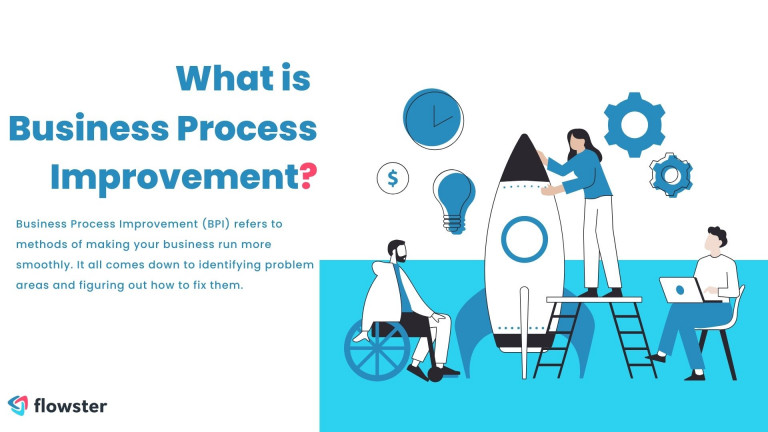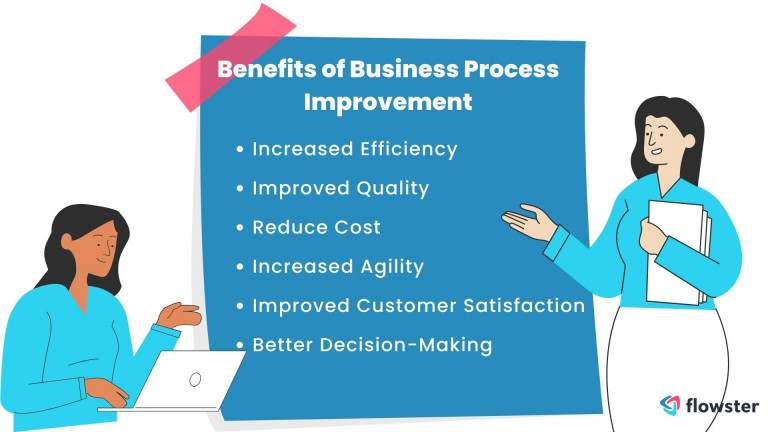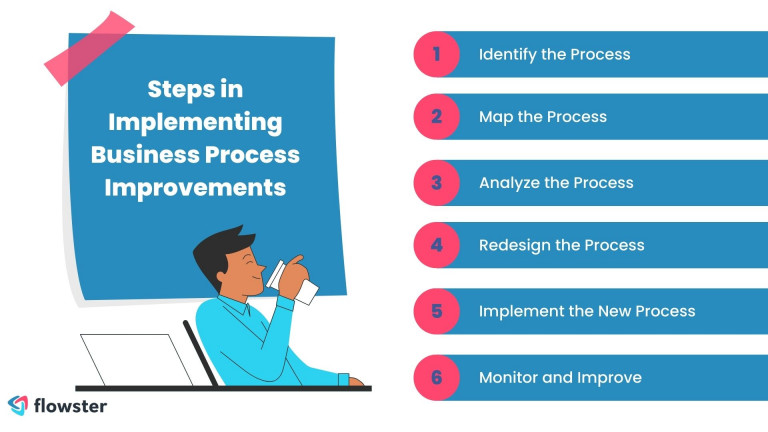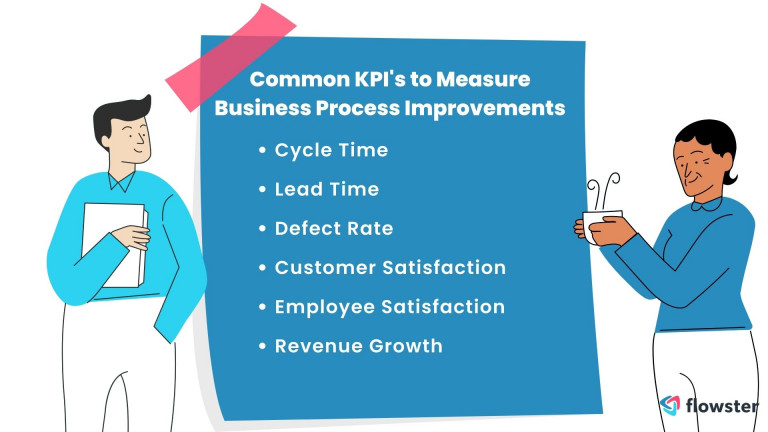Have you ever experienced delays or inefficiencies in your business operations? These issues can often result in higher costs, lower productivity, and decreased customer satisfaction. That’s where Business Process Improvement (BPI) comes in.
BPI is a method that helps businesses find and fix inefficient parts of their processes. This saves money, improves quality, and makes customers happier.
Without BPI, businesses may struggle to keep up with competitors, lose customers, and experience financial setbacks.
In this article, we’ll talk about the benefits of Business Process Improvement (BPI) and give you tips on how to use it in your business.
You’ll learn about real-world examples of successful BPI strategies, common BPI tools and techniques, and how to measure the impact of BPI efforts.
By the end of this article, you’ll have the knowledge and skills needed to take your business operations to the next level and achieve long-term success. So, let’s dive in!
Article Outline
What is a Business Process?
In a nutshell, a business process is a set of tasks or activities that a company performs to achieve a specific goal. Think of it like a recipe: each step in the process is like an ingredient that, when combined with the others, creates a finished product.
Business processes can be simple or complex, depending on the size and nature of the company.
For example, a small retail store might have a simple sales process that involves greeting customers, answering their questions, and completing transactions.
A large manufacturing company, on the other hand, might have a more complicated process for creating, testing, and making products.
Why are Business Processes Important?
Well, they provide a structure for how work is done within a company. By standardizing existing processes and ensuring that everyone is on the same page, businesses can work more efficiently and effectively.
This can lead to improved productivity, better quality, and happier customers. To give you an idea of the different types of business processes out there, here are a few examples:
- Sales process: This involves the steps a business takes to sell a product or service, from identifying potential customers to closing the deal.
- Supply chain process: This encompasses everything involved in getting a product from the supplier to the customer, including sourcing materials, manufacturing, and shipping.
- Hiring process: This covers the steps a company takes to find and onboard new employees.
- Customer service process: This describes how a business works with its customers to help and support them.
By understanding what business processes are and why they matter, companies can identify areas for improvement and implement BPI strategies to make their operations even better.

What is Business Process Improvement (BPI)?
Business Process Improvement (BPI) is a fancy term for finding ways to make your business run more smoothly. It’s all about identifying areas where things aren’t working well and figuring out how to fix them.
To mention a few, it is also known as business process management (BPM), business process re-engineering, and continuous improvement process (CIP) or continuous process improvement.
By doing this, you can make your business more efficient, reduce costs, and make your customers happier.
For instance, let’s say you own a small retail business. You might use BPI to improve your inventory management processes.
You would start by looking at how you currently manage your inventory and figuring out what’s not working. Maybe you have too much inventory taking up space, or you run out of stock too often.
You could fix these problems by using a “just-in-time” (JIT) inventory system, which would help you cut down on extra inventory and avoid stock-outs as much as possible.
You could also automate the tracking and reordering of your inventory to save time and cut down on mistakes.
Finally, you could train your employees on the new inventory management system to make sure everyone is on the same page.
By making these changes, you can improve your inventory management processes, save money, and keep your customers happy.
The great thing about BPI is that you can use it in any part of your business, whether you’re in manufacturing or customer service. It’s a powerful tool that can help you achieve your business goals more efficiently and effectively.
Benefits of Business Process Improvement
Business Process Improvement (BPI) can bring a whole range of benefits to your business! These benefits can be achieved by implementing BPI in any area of your business, from manufacturing to customer service.

Increased Efficiency
BPI can help businesses run more efficiently by finding and eliminating inefficiencies in business processes. This can lead to cost savings, improved productivity, and faster cycle times.
Improved Quality
BPI can help businesses find and fix problems in their processes, which leads to better quality and happier customers. By making it less likely for mistakes to happen and making things more consistent, businesses can make products or services that are more reliable and meet or exceed customer expectations.
Reduced Costs
BPI can help businesses find and get rid of costs that aren’t needed in their processes, which saves money and makes them more money. By cutting down on waste, making processes more efficient, and getting rid of steps that don’t add value, businesses can save money that can be used in other parts of the business.
Increased Agility
BPI can help businesses become more flexible by making it easy for them to respond quickly to changes in the market or to what customers want. By making processes better and getting rid of waste, businesses can be more flexible and better prepared to deal with changes in the market.
Improved Customer Satisfaction
BPI can help businesses make their customers happier by reducing lead times, improving quality, and making sure their products or services are always the same. By giving customers products or services that meet or exceed their expectations, a business can build customer loyalty and get an edge over the competition.
Better Decision-Making
BPI can help businesses make better decisions by providing them with more accurate and timely information. By collecting and analyzing data about their processes, businesses can make decisions that lead to better outcomes and results.
By implementing BPI strategies, businesses can reap these benefits and improve their overall performance. Whether a business wants to cut costs, improve quality, or make customers happier, BPI can help it reach these goals and improve its operations in a systematic way.
Business Process Improvement (BPI) Examples
Real-world examples of businesses that have used BPI strategies can help us understand what its benefits are and how it can be used in different situations. Check out these examples of companies that have succeeded with BPI:
- McDonald’s– You probably know this fast food giant, but did you know that they’ve used process improvement strategies like process mapping and Six Sigma to boost efficiency and reduce waste? By tweaking their processes and getting rid of non-value-added steps, they’ve increased customer satisfaction, cut costs, and made more money.
- Amazon– The online retail giant has used process improvement strategies like value stream mapping and continuous improvement to improve customer service and streamline their business. They have found and fixed bottlenecks in their supply chain and warehouses, which has helped them become one of the most successful companies in the world.
- GE– This multinational conglomerate has used process improvement strategies like lean manufacturing and Six Sigma to improve efficiency and reduce waste in its manufacturing operations. By getting rid of inefficient parts of their processes, they have improved the quality of their products, cut down on lead times, and increased their profits.
- Honeywell– The industrial conglomerate has used process improvement strategies like value stream mapping and Six Sigma to make their manufacturing operations more efficient and cut down on waste. By redesigning its processes and using data-driven decision-making, Honeywell has been able to increase productivity, reduce costs, and improve customer satisfaction.
These are just a few businesses that have used business process management strategies successfully. Other businesses can improve their operations, make more money, and reach their goals if they learn from their mistakes and use similar strategies.
Interested in improving your business processes?
Business Process Improvement Methodologies
When it comes to improving business processes, there are a bunch of methodologies and techniques out there that can help you identify inefficiencies and make things run more smoothly. Here are a few of the most common ones:
Process Mapping
This one is pretty straightforward; it just involves mapping out all the steps involved in a particular process so you can get a better sense of what’s going on. This can help you see where the bottlenecks are, how everything fits together, and where there might be room for improvement.
Value Stream Mapping
This one is similar to process mapping, but it’s more focused on the flow of materials and information through a process. By looking at the whole picture, you can get a better sense of where waste might be occurring, how long things are taking, and where you might be able to streamline things.
Six Sigma Methodology
This one is a bit more technical, but it’s all about using data to reduce defects and improve quality. You will gather and analyze data to figure out what’s going wrong and then use that information to come up with solutions.
Lean Process Improvement Methodologies
This one is all about reducing waste and improving efficiency. You’ll look at all the steps involved in a process and try to eliminate anything that’s not adding value while finding ways to make everything else run more smoothly.
These process improvement methodologies and techniques can be used alone or together, depending on what your business needs.
For example, you might use process mapping to get a better sense of what’s going on and then use Six Sigma to figure out what’s causing problems and how to fix them.
Or, you might use value stream mapping to see where things are getting bogged down and then use Lean methodologies to get rid of anything that’s slowing you down.
By using these common business process improvement methodologies and techniques, you can get a better understanding of what’s going on in your business, find areas for improvement, and come up with solutions that make things run more smoothly.
Steps in Implementing Business Process Improvements
To keep up with the competition, you need to be open to continuous improvement and get rid of inefficient processes. The question then is: How can an improvement to a business process be effectively implemented? Take the following steps:

Step 1: Identify the Process
The first step in improving a business process is figuring out which parts of the current process need work. This can involve looking at data, talking to employees or customers, or checking performance metrics.
For example, a manufacturing company might realize that their assembly line process needs improvement because it’s taking too long and there are too many defects.
Step 2: Map the Process
Once the process has been identified, the next step is to map it out. This means creating a visual representation of the process and figuring out all the steps involved.
For example, the manufacturing company might make a map of the assembly line process, showing how raw materials are turned into finished products.
Step 3: Analyze the Process
After mapping out the process, it’s time to analyze it to find out where things could be better. This can involve gathering data, watching the process in action, or asking employees for feedback.
For example, the manufacturing company might watch the assembly line in action and track things like defect rates and cycle times to see where they can improve.
Step 4: Redesign the Process
Once the problem areas have been identified, it’s time to redesign the process. This can mean getting rid of steps that don’t add value, automating parts of the process, or rearranging things to make them flow better.
For example, the manufacturing company might get rid of a step in the assembly process that isn’t necessary and use an automated quality control check instead.
Step 5: Implement the New Process
After the new process has been designed, it’s time to put it into action. This means training employees, making changes to equipment or facilities, and updating documentation.
For example, the manufacturing company might train employees on the new assembly line process, make changes to the equipment to make it work better, and update manuals and instructions.
Step 6: Monitor and Improve
The final step is to monitor the new process and make changes as needed. This can involve collecting more data, talking to employees or customers, or reviewing things periodically.
For example, the manufacturing company might track defect rates and cycle times to make sure the new process is working well and make further changes if needed.
By following these steps, businesses can continually improve their processes and achieve better results.
Tips in Implementing Business Process Improvement
Now that you know the steps to effectively implementing business process improvement, let’s dive into a few more tips to ensure you’re on the right track.
Involve Your Team
Firstly, it’s important to involve your team in the process. After all, they’re the ones who will be using these processes on a day-to-day basis, so their input is valuable. You can ask for their feedback on the new processes you’ve created and make changes accordingly.
Make it Scalable and Adaptable
Secondly, make sure your processes are scalable and adaptable. As your business grows and evolves, your processes should be able to keep up. So, think about how you can make them flexible enough to accommodate changes.
Monitor Your Processes
Lastly, don’t forget to measure the success of your processes. Set up metrics to track how well they’re working and make adjustments as necessary. This will help you continuously improve and refine your processes over time.
By using these extra tips, you can make improvements to business processes that are not only effective but also flexible and measurable.

Tracking Business Process Improvement Efforts
Once you’ve put business process improvement methodologies in place, it’s important to keep tabs on their impact and track your progress. This way, you can find opportunities for further improvement and show everyone how effective your efforts have been.
One way to measure the results of a process improvement methodology is to use key performance indicators (KPIs). These are metrics that you can use to assess how well your process or system is performing.
By tracking KPIs before and after implementing a process improvement methodology, you can see how much of an impact your efforts have had on the process.
Common KPIs to Measure Your Business Process Improvements
There are lots of KPIs you can use to measure the impact of process improvement, but some common ones include:
- Cycle time – This measures how long it takes to complete a process, from start to finish. By shortening your cycle time, you can boost efficiency and productivity.
- Lead time – This measures how long it takes for a process to go from the initial request to completion. By reducing lead time, you can make your customers happier and more responsive.
- Defect rate – This measures the number of defects or errors in a process. By lowering the defect rate, you can improve your product quality and reduce waste.
You can also use other KPIs, like customer satisfaction, employee satisfaction, and revenue growth, to gauge the impact of process improvement.
To measure the impact of improving processes effectively, it’s important to establish a baseline for each KPI before you start making changes.
This gives you a benchmark for measuring progress over time. You should also check on your KPIs regularly and tweak your process improvement strategies as needed to keep making progress.
By using KPIs to measure the impact of improved processes and keeping tabs on your progress, you can keep making improvements to your operations over the long haul and show everyone how well your process improvement efforts are paying off.
Business Process Improvement Through Automation
Automation can be a useful tool for process improvements because it can help businesses streamline their existing processes, cut down on mistakes, and get more work done in less time.
Help Improve Efficiency
By automating boring and time-consuming tasks, businesses can free up workers to do more important tasks that require more creativity and decision-making.
For example, a company might use automation to help with its invoicing process. By using an automated system to create and send invoices, the company can reduce the chance of mistakes and give its accounting team more time to work on more complex tasks, like the financial analysis.
Real-Time Monitoring
Another benefit of automation in process improvement is that it makes it easier to gather and analyze data. When businesses have automated processes in place, they can collect data in real time and use analytics tools to quickly find trends and places where they can improve processes.
This can help businesses make decisions based on data and change their processes quickly to improve their performance.
It’s worth noting that while automation can be a powerful tool in BPI, it’s important to approach it thoughtfully. Not all processes can be automated, and before putting automation in place, it’s important to think about things like cost, complexity, and how it will affect employees.
Also, businesses should make sure they have the resources and skills they need to set up and manage automated systems well.
Overall, automation can be a valuable tool for improving processes. It can help streamline business processes, make them more efficient, and help make decisions based on data. By approaching automation thoughtfully and strategically, businesses can achieve long-term improvements in their operations.
Conclusion
In conclusion, Business Process Improvement (BPI) is an important way for businesses to find, analyze, and improve their processes in order to make them more efficient, productive, and profitable.
By following the steps of the continual improvement process—finding the process that needs to be improved, mapping it, analyzing it, redesigning it, putting the new process in place, and keeping an eye on it—businesses can make big changes to how they run.
Also, automation can be a big part of process improvement by reducing the amount of work that needs to be done by hand, cutting down on mistakes, and making the process more efficient.
Businesses can streamline their operations, cut costs, and improve their competitive edge in the market by using automation tools.
For process improvement to be successful in the long run, it’s important to use key performance indicators (KPIs) to measure how well it’s working and keep track of progress over time.
By setting a baseline and reviewing KPIs regularly, businesses can find areas where they can improve, make the necessary changes, and continue to improve their processes.
Overall, business process improvement (BPI) is a continuous process that requires an organization to have a culture of continuous improvement.
In today’s competitive market, businesses can grow and be successful over the long term if they use continuous improvement every day.
Have you implemented process improvement strategies in your own organization? We would love to hear about your experiences and any tips you might have. Please feel free to share in the comments below!
Ready to Create Your First Business Process Workflow?
Start from scratch to make a business process workflow, or look through our templates in Flowster’s Marketplace.
Want help? Use our “Done for You” service to let our experts build custom workflows for you.
Related Articles
Would you like to learn more? See our other informative articles.
The Complete Guide to Change Management Process (with Free Templates)
What Process Management Tool is Right For You? Flowster vs Alternatives
How Business Process Mapping Helps You Manage and Scale Your Business


